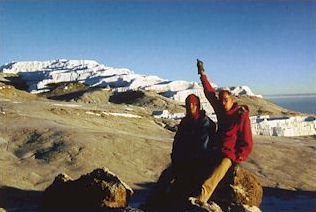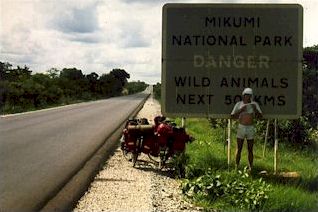The brilliant reflection of the moonlight on the rocks stands out against the backdrop of a deep blue night sky. There is no need for torches now but woolen caps and gloves are essential to protect against the blistering cold. It is probably -15°C and the fresh snow spreads the light evenly across the steep ascent.
 |
Yes, yes, quite right, we still talking about Africa here and we're even in close proximity of the equator, to the south of it to be exact. But this is the landscape that surrounds us at 5000 meters height above sea level. Add another 800 meters to that and we will have reached Africa's highest point, the peak of this inactive volcano, the Kilimanjaro. The air is very thin up here, every step requires a strenuous effort and headaches, vertigo and nausea turn the last stage into absolute agony. Almost every one in our small group is afflicted. And after eight months of African heat, Jens and I are struggling to adjust to the extreme cold. We reach the top in time for sunrise, this is the only time of the day that it is open. One hour later the clouds will hide the summit once again. But now, beautiful scenes of sparkling glaciers and unusual icefalls unfold before us and in the early morning light we overlook Kenya and Tanzania, deep down below us. In the warming raise of the sun we forget, for a moment, the aches and pains and take in the magnificence of this unforgettable view before making our way down to the last camp. With light diminishing and air pressure increasing, the headaches become less intense and so we are all quite eager to get down. It took us 3 days to climb up through all the climate zones, ranging from thick jungle, vast empty fields to rocky deserts. Not a cheap expedition, this tour through the everlasting snow, which, coming from the Tanzanian side costs 100 EUR per person. On top of that the stipulated guides. But they had more than enough on their hands, sorting out their own circulatory problems, than with us. We choose to abstain from hiring carriers for our luggage as it is normally done. After all, we had managed just fine, so far.
 |
Four weeks earlier we had left Uganda's Capital, Kampala, heading for Kenya . Riding along Lake Victoria, which is shared by Uganda, Kenya and Tanzania, we reach the original source of the Nile. From here, at the north end of the lake, Africa's longest river starts its long journey to the Mediterranean Sea, from which point we had entered the continent 8 months before. Now in Kenya, we cross the equator for the third and last time. Every village has a supply of milk, bread and beer. A steep road behind Lake Victoria makes its way up the mountain to the cool and dry Kenyan Plateau. We peddle up along the road, not moving much faster than the train next to us, which seems to be out of breath itself. Just like us. Having reached the highest point at 2 600 meters, a steep descent awaits us into the "Rift Valley". This valley is part of a huge fault-zone in the earths crust, which stretches from the Red Sea in Asia Minor down to Mozambique.
 |
Kenya and Tanzania are often associated with national wildlife parks. For the animals there, already fairly used to humans and their cars, two lonely German cyclists must be just a strange sighting, just as giraffes are to us back home in Germany. The monkeys are less afraid of us and we seriously have to step on the peddle to get these sly little baboons off our backs. One evening, camping by the wonderful Naivasha Lake in the Rift Valley, we are awoken by strange noises. A hippo family is taking one of their evening strolls not too far from our campsite. The thought of our humungous visitors not registering our dark little tent was rather left un thought.
After leaving the Rift Valley on the east side, we reach Kenya's capital Nairobi, 1600 meters above sea level. Christian churches, Indian temples and mosques lined up in a row. As international is the kitchen. There is even a German restaurant, memories of Lome, Togo's capital pops up in my mind. Many little slums, in which many houses and shacks are regularly torn down, the owners receiving no compensations of any kind whatsoever, surround the modern skyline. While talking to some students, I find out that these occurrences have very well been brought to the attention of the press and they are discussed thoroughly, something very unusual for African countries. We leave the crowded city behind us, and cycle through the Masai grasslands to Tanzania. The Masai, nomadic warriors, were slowly but surely chased away from the fertile south to the dry planes of the north at the beginning of the century. This is where they, still to this day, live by their ancient traditions, away from modern technology. They are very beautiful, tall people with huge holes in their ears and colorfully decorated bodies. Industrially seen, Tanzania is worse off than Kenya. Socialism has to give way to investments and privatizations more and more. The inflation rate is very high and the course changes almost daily. Our frameworks, no longer able to accommodate the bundles of money which we had to smuggle over the Kenyan and Tanzanian borders, now have to be replaced by socks and shoes as a new means of transport for our currencies. The best sleeping place along the coast yet was in a Kenyan train station, the most entertaining in the country, a stationmaster told us, proudly pointing at three golden stars above the entrance of his station. Various sections of this railroad is controlled by special keys to operate signals along the line and are cleared by telephone. They are artistically thrown to the moving trains drivers and while demonstrating this art to us, the stationmaster forgot to clear the second train in the station - much to our delight.
On 11 November we finally reach Mombasa, after over 6000 km through Africa, from the Atlantic in Cameroon to the Indian Ocean in Kenya. The Indian and Arabic influences in Mombasa are clearly present. Many Asians have lived here over three generations already and control the best parts of the local economy. Jens and I decided to leave the hot, humid city to stock up energy on the beach for the next 6000 kms to Cape Town. Coral reefs and white palm tree beaches, just like in the picture books. A few kilometers further on are the tourist hotels, well guarded to show the tourist parts of Africa. It is 30 degrees C and tomorrow we have
To download page Beginning of page Next page